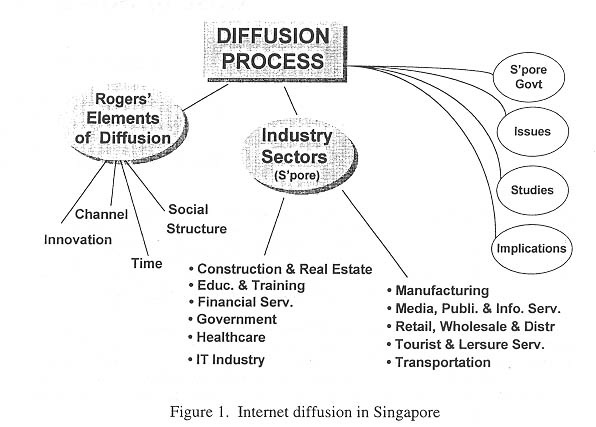
Edna O.F. Reid
Division of Information Studies
Nanyang Technological University
Singapore 2263, Singapore
E-mail: Asreid@ntuvax.ntu.ac.sg
Using Singapore as a model, the diffusion of Internet is analyzed. Within the context of strategic planning, a stage approach for observing and planning Internet dispersion within an organization is described. Using the stage approach called the Internet Life Cycle, managers can identify key issues that need to be addressed in the systematic planning for using Internet as a prototype for an information superhighway.
This study provides an overview of the government's use of Internet in planning for a global information infrastructure in Singapore. It analyzes the dispersion of Internet within Singapore and relates it to the country's information technology (IT) planning. Within the context of Singapore's IT2000 and Library 2000 strategic plans, it traces how Singapore is progressing in the development of Internet as a prototype for its National Information Infrastructure (NII). As predicted by Kahn (1994, p. 15) and illustrated by Singapore, the role of governments is expanding to include more involvement in the development of Internet.
Within Singapore's IT2000 plan, the Singapore Government is using a systematic process for integrating Internet into the government and private sectors as well as using it to develop an indigenous on-line industry. The IT2000 plan outlines a strategic vision to develop a NII. It was followed by the Library 2000 report, a plan calling for the re engineering of library services throughout the country.
The framework used for this research is Rogers' diffusion model. Using Rogers' (1995) diffusion model, tracing methodology, secondary data sources, personal observation and participation, the activities of the Singapore Government in relation to Internet were analyzed. The speeches, publications, World Wide Web (web sites), and conferences were traced over a four year period (1992-1996 August). The data were compiled and indexed in the Non-numerical Data Indexing System (NUDIST) database. Figure 1 provides a schematic overview of the diffusion study. After discussion of IT strategic planning in Singapore, the Government's diffusion of Internet is analyzed. Within the context of strategic planning, a stage approach for observing and analyzing Internet dispersion is described.

2. INFORMATION TECHNOLOGY PLANNING IN SINGAPORE
The Singapore Government actively promotes IT in the economy. Since the early 1980s, the Government has recognized the need for IT. Its IT initiatives evolved in three phases, each framed by a national plan that clearly articulated goals and projects. Chun (1995, p. 152), Liang (1993) and Soh (1995) analyzed IT planning and implementation in Singapore. They classified IT planning and development into three distinct phases. The first phase from 1981 to 1985 saw the start of the Civil Service Computerization Program and the establishment of the National Computer Board (NCB). The NCB is the statutory board responsible for computerization planning and development. Important outcomes of the first phase are the development of a cadre of local computer professionals and of government applications mainly in the areas of transaction processing and database management systems.
By 1985 considerable progress had been made. In addition, Singapore experienced a recession. An IT planning committee, led by NCB, recommended a new strategic plan that focused on the local IT industry, IT applications to support business competitiveness, and telecommunications infrastructure (Soh, 1993, p. 8). These recommendations were included in the 1986 Report of the Economic Committee and accepted by the government. During this the second phase, 1986-1990, the National IT Plan (NITP) was developed and implemented.
The NITP is a comprehensive plan that transformed Singapore's newly industrialized economy into one that is high-tech oriented. It emphasized the development of the private sectors in such areas as IT industry, IT applications, IT manpower, and communication infrastructure. Liang (1993, p. 331) describes the NITP as using a strategic building block approach that serves as a catalyst to achieve the objective of exploiting IT for economic and social gain. Table 1 lists the building blocks such as the IT industry. A strong, local IT industry is recognized as the driving force needed to push the economy towards a higher level of performance. He identified the following approaches to achieve a stronger IT industry:
• to establish Singapore as a center for the development of niche IT products;
• to develop the indigenous capability of the local IT industry; and
• to encourage more IT multinational companies to set up their regional headquarters in Singapore.
Some of the approaches are also being applied to the development of an Internet industry in Singapore.
Table 1. Strategic building blocks (from Liang, 1993)
| IT Industry |
| IT Application |
| IT Manpower |
| IT Culture |
| Information Communication Infrastructure |
| Climate for Creativity & Entreneurship |
| Collaboration & Coordination |
Five years after the formulation of the NITP, a steering committee was again convened to map out an even more aggressive plan to facilitate a higher level of IT usage. Like the previous IT planning efforts, IT2000 planning focused on increasing the competitiveness of Singapore. In 1991, the launch of IT2000 master plan is the third and current phase of IT planning. The objective of the IT2000 plan is to develop Singapore into an intelligent island. To accomplish this, it outlines several strategic thrusts. The vision of IT2000 is to link every home, office, and government ministry by 2005 through an intelligent communications network called the National Information Infrastructure (NII). The components of the NII include conduit, content, and compute (A vision, 1992, p. 39). Although Singapore is continuously developing its IT industry and telecommunications infrastructure, more advanced industries and infrastructures are needed. Additionally, it is substantially lacking in local content.
Organized around eleven industry sectors (Figure 1), IT2000 proposes higher levels of integration among computing, telecommunications, business services, and social activities than the previous plans. Since it involves multi-agency participation, the different government ministries such as the Ministry for Information and the Arts (MITA) and the Ministry of Education (MOE) started to investigate the potential of IT2000 developments for their ministries.
In response, government ministries started to review their roles in implementing the IT2000 vision. In 1992, the Minister for Information and the Arts appointed a Review Committee, headed by NCB, to suggest ways of revitalizing the public library system in Singapore. In 1994, the recommendations contained in the Library 2000 (1994) report were accepted by the government. The major recommendations were to develop an adaptive public library service and set up a network of borderless libraries. Additionally, it recommended the development of an adequate supply of new age information professionals, the use of automation to reengineer library services and the establishment of a new statutory board to manage and implement the recommendations. The re engineering of library services fits within the Media, Publishing and Information Services sector of the IT2000 Plan. Reid's (1996b) study analyzes the Library 2000 recommendations within the context of IT2000 and Internet.
According to Stephen Yeo, Chief Executive of NCB, "IT2000 dream to make Singapore a fully-networked nation is becoming a reality" (Straits Times, August 9, 1995). He attributes a major reason for the rapid progress to the growing popularity of the Internet. Internet has given people an idea of what IT2000 can be and how services can function in network environments.
3. DIFFUSION OF INTERNET IN SINGAPORE
As indicated in the brief review of IT planning, the Singapore Government uses a proactive and direct approach in promoting IT in the economy. Also, this is applicable in the diffusion of Internet. Stoneman and Karshenas (1993, p. 177) describe the adoption of new technologies as the diffusion process.
According to Rogers' diffusion model (Rogers, 1995, p. 35) ,diffusion is viewed as the process by which an innovation is communicated through channels over time among members of a social system. It is a special type of communication that is concerned with the spread of messages in which the content is perceived as new ideas. Figure 1 illustrates the four main elements in the diffusion of new ideas such as innovation and communication channels. In reference to Internet, it is viewed as a technological innovation that has created a lot of uncertainty. The characteristics of an innovation, as perceived by members of the social system, determines the rate of adoption. The five attributes of innovation are relative advantage, compatibility, complexity, trialability, and observability. Figure 2 lists the attributes and examples from Singapore.
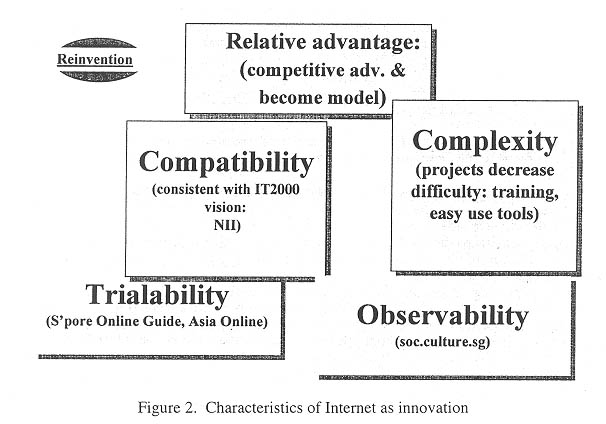
Since Internet is consistent with the Singapore Government policy of exploiting technology and implementing the IT2000 plan, it is perceived as providing a competitive advantage. Early Internet projects such as the Singapore On-line Guide and Singapore's InfoMap were trials by the NCB to test the usefulness of the global network. The Singapore On-line Guide is the interactive version of the Singapore Tourist Promotion Board's (STPB) brochure. Initiated in 1994, it was a joint project between STPB and the NCB. Also introduced in 1994, Singapore's InfoMap was established as the official web site for disseminating government information about Singapore. Later, the governments of Thailand and Malaysia introduced their official government web sites.
Activities on the web sites and the news group (soc.culture.sg) were closely reviewed. By 1994, the Singapore Government made a decision to support the diffusion of Internet. The Singapore Government used the mass media as a communication channel to describe the potential advantages and uses of Internet. Between 1993 and 1996 (March), 1592 newspapers articles were published in the local Singapore press. The local press includes English language papers such as The Straits Times, The Business Times, as well as Malay and Chinese language papers. All of the papers are published by the Singapore Press Holdings (SPH). Table 2 provides a distribution of the Internet news stories. The year 1995 was declared "year of the Internet in Singapore. It was discussed from commercial, educational, national, and political perspectives such as the use of Internet for distance education and dissemination of information by grassroot leaders.
Table 2. Distribution of Internet-related news stories in Singapore
|
|
in SPH papers |
|
|
|
|
|
|
|
|
|
|
|
(January-March) |
Additionally, the Government advised all ministries
to publish on the Internet and use it for prototyping more electronic services.
In 1995, the National Library, Urban Redevelopment Authority, and the Labor,
Defense, and Foreign Affairs ministries began putting information on-line
(Yap, January 2, 1996). Some government ministries have Internet and Intranet
(interior to the organization) servers.
4. DEVELOPMENT OF INTERNET INDUSTRY IN SINGAPORE
In Table 1, the building block approach described under the NITP is applicable to the development of the Internet industry. A strong, local industry is recognized as a driving force needed to push the development of Internet and on-line industry. This article only focuses on the first building block: the Internet Industry.
The strategies identified to achieve a strong Internet industry are:
• to develop the indigenous capability of the local on-line industry; and
• to encourage companies to develop world-class services and expand throughout the region.
According to another article in The Straits Times (March 23, 1996), the Internet has resulted in the establishment of ISPs, about twenty new businesses and $10 million in revenue in 1995. Some of the new Internet businesses provide Internet access, training, electronic publishing and financial services. The growth can be associated with the Singapore Government positive promotion of Internet. The Government established policies for three ISPs to be licensed and reviewed by the Telecommunications Authority of Singapore (TAS); local companies to be involved in reselling Internet access and entrepreneurs to be encouraged as well as supported. Additionally, the Government has authorized the Singapore Broad-casting Authority (SBA) to regulate content and establish procedures for censoring the Internet.
"In announcing its Internet strategy, the Government said it will jump in as Government, as the youth division of one of the political parties, and as commercial establishments" (Straits Times, Mar 18, 1995). The following are some steps that the Government has taken to encourage and support Internet usage. First, the Government has made selling Internet access technologically and economically feasible. For example, the TAS licensed several Internet Service Providers (ISPs): Pacific Internet, SingNet and Cyberway. ISPs are owned by large government-linked companies such as Pacific Internet is owned by a consortium of local companies and SingNet is owned by Singapore Telecoms (country's only domestic telephone company). Table 3 provides a comparison of the ISPs.
Table 3. Singapore's Internet service providers (ISPs): Comparison
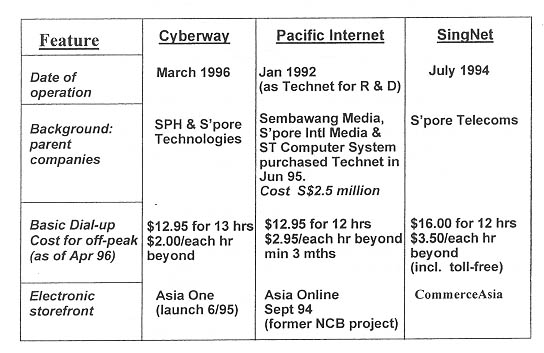
Pacific Internet is the most experienced Internet access provider in the region. In 1991 it was set up as the Technet Unit at the National University of Singapore (NUS). It was funded by the National Science and Technology Board (NSTB) to provide Internet services to the education, research and development communities. In keeping with the government's approach of privatizing government services, it was acquired by a consortium of three companies in 1995. The SOG believes that privatization will make an organization more competitive, innovative, and efficient (Straits Times, October 95). After the acquisition of Technet in June 1995, it was renamed Pacific Internet Pte Ltd.
Second, the Government has encouraged the creation of new products and services. One example is Pacific Internet. In a closed government tender, the companies that purchased Technet are Sembawang Media, ST Computer Systems and Singapore International Media. According to the Sembawang Corporation's Annual Report (1995, p. 57), Sembawang Media (SembMedia) was formed in March 1995 to exploit business opportunities in the Internet market in Asia. SembMedia is a subsidiary of Sembawang Corporation Pte Ltd. and its objective is to build new on-line services and communities on the Internet while pioneering an Asian approach to on-line services.
Figure 3 illustrates SembMedia's relationship to Sembawang Corporation. In addition to purchasing shares in Pacific Internet, SembMedia purchased shares in Silkroute Pte. Ltd., Macroline (Malaysia) and SuperNet (Hong Kong). Silkroute was a project that originated in the Digital Media Center (DMC) of the National Computer Board. Personnel at the DMC and the National University of Singapore were actively setting up gopher and World Wide Web servers as well as designing home pages. Additionally, they were being asked to design Web pages for commercial companies. Since the Web was so new, Singapore did not have any Internet publishing companies. In 1994, members of the DMC initiated a project to start the first commercial Internet web publishing company called Silkroute. Silkroute, with its Internet server in the U.S., established an electronic storefront called Asia On-line. For its web publishing venture, it secured contracts with several companies such as Reed Exhibition Company and Singapore Tourist Promotion Board (STPB). Reed Exhibition handles major trade fairs such as Asian Aerospace and Asia Travel Mart.
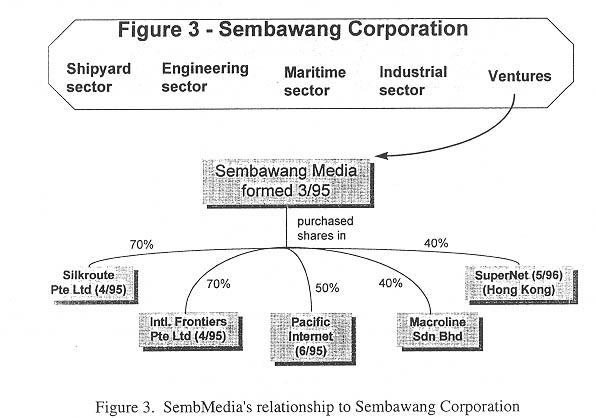
Now, Silkroute is a thriving publishing business with operations in Singapore and Malaysia. It has more than 60 business subscribers, compared to about 35 to 40 in 1995 (Straits Times, September 1, 1996, p. 5). Customers are coming from different industry sectors such as banks, government statutory boards and hotels. According to an Internet specialist in Singapore, the typical charges for setting up home pages range from $500 to $30,000, depending on the design, quality, number of pages and professional competence. With pioneers from NCB, Silkroute is highly competent.
Third, the Government has stimulated the creation of new businesses within old ones. A company with telecommunications and information processing embedded in its value chain may have excess capacity or expertise that can be sold in a new market. For example, in 1994 the Singapore Telecoms used its telecommunications expertise to secure a license to operate the first commercial ISP in Singapore. Singapore Telecoms was just privatized in 1993. The concept of creating new businesses within old ones also applies to Cyberway, the third ISP. Singapore's only newspaper company, Singapore Press Holdings (SPH) and the Singapore Technologies used their publishing and technological expertise to win successfully the tender for the third ISP. The major advantages of Cyberway are its business-focus and local content (Singapore newspapers).
5. TRENDS IN ISPs DEVELOPMENT
Within the emerging Internet industry in Singapore, the rules of competition are changing in several ways. The trends that were identified are in line with Drucker's (1995, p. 65) analysis of managing in network society. According to Drucker, countries are progressing towards a network society in regard to the relationships between organizations and individuals who work for them, and in respect to the relationships between different organizations. Managing will require different behavior, skills, and attitudes.
A visible example is outsourcing in which an organization contracts out an entire function to an independent firm that specializes in that work. There are many incidents of outsourcing in Singapore. At the Nanyang Technological University, the information processing and help desk functions are outsourced to Digital Equipment Company (DEC). Cyberway outsource its new subscriber registration and training to Informatics Computer School. Informatics is an international franchise in IT training and education with over 75 centers in 16 countries in the Middle East, Southeast Asia, India and China (Straits Times, January 9, 1995). Singapore Tourist Promotion Board, Reed Exhibition Company, Holiday Tours and Westin Plaza Hotel outsource their Web publishing and maintenance to SilkRoute.
In addition to outsourcing which has become routine for some businesses, Drucker (p. 69) emphasizes another trend is toward alliances as the vehicle for business growth. Internet industries are stimulating alliances and joint partnership such as with Pacific Internet, Cyberway and several cybercafes. Cyberway and the National Computer Systems (NCS) have formalized an agreement where NCS will be a reseller of Internet access and recommend that all of its new clients use Cyberway. NCS offers a full range of Internet services including Web publishing, electronic commerce, intranet consultancy, help desk services and training (Straits Times, April 9, 1996). It is a company formed from the National Computer Board. Of the 900 employees needed for NCS, 700 were formerly NCB employees. This is in line with the Singapore Government policy of privatizing government services.
The ISPs are using their alliances to differentiate their services and products. Cyberway is offering access to Internet and several specialized regional database services. It seems to be designing service similar to commercial on-line companies such as CompuServe and America On-line (AOL). For example, Cyberway offers business information that is published in local and regional newspapers such as Business Times and The Straits Times. This service is called AsiaOne and provided by the Multi-media Division of the Singapore Press Holdings (SPH). The current manager of Cyberway is the former head of the Multi-media Division of SPH. AsiaOne plans to establish itself as the premier place for business news and information on Singapore and its Asian partners. In addition to newspapers, several business directories, bulletin boards, and white pages are also available.
The trend towards alliances extends across local , regional and international boundaries. ISPs have formed alliances to resolve some technological issues such as congestion, slow response time and US centric network. One strategic alliance is the Asia Internet Holding (AIH). AIH is a consortium comprising Pacific Internet, Internet Initiative Japan, Hong Kong Supernet and Sumitomo Corporation. The objective of AIH is to build and operate the Internet backbone for ISPs in Asia, in place of direct connections from the various ISPs to the US or Europe. It is trying to develop a distributed high-speed hub with Tokyo as the main network node.
At the same time, SingNet is setting up its own version of an Asian Internet backbone which may promise faster and cheaper access for regional users. It is planning a backbone which routes Asia Pacific traffic directly within the Asia Pacific region, instead of begin channeled to the US first and then back to the region. Additionally, SingNet is further enhancing its differentiation strategy by using a regional approach. It has entered into partnerships to be the service provider for fourteen regional customers including ISPs located in the Philippines, Vietnam, China, Sri Lanka and Brunei (SingNet, 1996).
6. CHALLENGES TO MANAGEMENT
After reviewing the trends in the development of Internet in Singapore, an immediate response is to ask how are managers responding to the challenges of a global network. Since Internet is having a significant influence on managers, a framework for planning and analysis of Internet usage is presented. In Reid's (1996a, p. 20) earlier study, she outlined a stage approach called the Internet Life Cycle. The Internet Life Cycle provides some general conditions that prevail in the use of Internet. However, the framework is descriptive and therefore can serve as a guide to observe and analyze Internet development. Additionally, it outlines another approach for strategic planning of Internet as a prototypical model for designing and testing services for network environments.
Table 4 presents an overview of the stages in the Internet Life Cycle. They have several similarities to Gibson and Nolan's (1976) stages of data processing developments and Huff et al (1988) stages of end user computing. For the Internet Life Cycle, the stages include:
• Exploration,
• Integration,
• Diffusion, and
• Strategic Exploitation.
In the Exploration stage, the organization secures
some type of Internet access. Managerial support is evolving but there
are concerns regarding security, time management and control. Management
starts to investigate information to reduce uncertainty about Internet.
The Integration stage involves a progression in Internet knowledge and
applications. Management starts to evaluate Internet usage and makes a
decision to reject or accept the new innovation. The fourth stage, Diffusion,
involves a wider dispersion of Internet usage throughout several functional
areas. Finally, the Strategic Exploitation stage involves using Internet
for transforming business processes. This can help companies address some
of the complex issues of globalization, technological developments, and
client-focused services. This type of approach is being tested in several
organizations in Singapore.
Table 4. Internet life cycle in organization
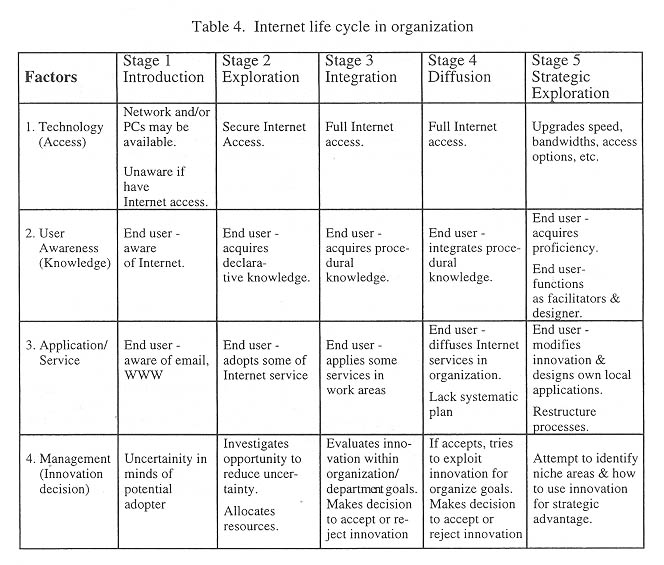
6. CONCLUSIONS
In Singapore, the Government recognizes the importance of Internet in its information technology planning and implementation. Within Singapore's IT2000 plan, the Singapore Government (SOG) is using a systematic process for integrating Internet into the government and private sectors. The IT2000 plan outlines a strategic vision to develop a National Information Infrastructure (NII). It was followed by the Library 2000 report, a plan calling for the restructuring of library services throughout the country.
With extensive Government support for Internet services, managers must review the organization's capabilities for providing more network-based services. Although Governments are leading the effort, managers must design strategic and operational plans for integrating Internet into the organizations. A stage approach for analyzing and planning Internet dispersion within an organization was described. Using the stage approach called Internet Life Cycle, managers can identify key issues that need to be addressed in the systematic planning for using Internet. In the Internet Life Cycle, the stages include Introduction, Exploration, Integration, Diffusion, and Strategic Exploitation. Important aspects of the stage approach are the development of managerial support and employees knowledge regarding Internet services. Managers must develop an understanding of the competitive advantages and disadvantages of Internet services as well as how to integrate them into business operations. They must monitor the activities and strategies of governments so that they are proactive players in the development of the information superhighways.
REFERENCES
A Vision Of An Intelligent Island: IT2000 Report. (1992). Singapore: National Computer Board.
Chun, Wei Choo. (1995, October). National computer policy management in Singapore: Planning an Intelligent Island. Proceedings of the ASIS Conferenc. pp. 152-156.
Cronin, M. (1994). Doing Business On The Internet. New York: Van Nostrand Reinhold.
Drucker, P.E. (1995). Managing in a Time of Great Change. New York: Dutton.
Gilbert, A.L., Soh, C., and Neo, Boon Siong. Telecommunications as a strategic element in the national infrastructure system: Three eras in the development role of telecommunications in Singapore. Available at http://www.ncb.gov.sg/itpolicy.
Huff, S.L., Munro, M.C., and Marlin, B. (1988). Growth stages of end user computing. Communications of the ACM, 31: 542-550.
Kahn, R.E. (1994). Viewpoint: The Rrole of government in the evolution of the Internet.
Communications of the ACM, 37 (8): 15-19.
Liang, T. (1993). Organized and strategic utilization of information technology: A nationwide approach. Information & Management, 24: 329-337.
Library 2000: Investing in a Learning Nation: Report of the Library 2000 Review Committee. (1994). Singapore: SNP Publishers.
Ngian, L.H. (1995). Public libraries in Singapore: Responding to needs & changes. Asia-Pacific Library Conference, May 1995, Brisbane, Australia. pp. 119-131.
Porter, M., Millar, V. (1991). How information gives you competitive advantage. In Revolution in Real Time: Managing Information Technology for the 1990s. Cambridge, Mass.: Harvard Business Review Press, pp. 59-82.
Reid, E.O.F. (1995). Challenges of Internet diffusion in Southeast Asia. Singapore Libraries, 24: 79-93.
Reid, E.O.F. (1996a). Exploiting Internet for transforming library services. IFLA Journal, 22 (1): 18-26.
Reid, E.O.F. (1996b, August). Strategic utilization of Internet: Singapore's IT2000 and Library 2000 Plans. IFLA Conference, Beijing, PRC.
Rogers, E. (1995). Diffusion of Innovations. 4th ed. Prentice-Hall.
Sembawang Corporation. (1995). Annual Report 1995. Singapore.
SingNet. SingNet paint Asia backbone vision. Available at http://www.singnet.net.sg.
Soh, C., Neo, B.S., and Markus, M.L. (1993). State-wide Strategic Planning for IT: A Critical Appraisal of the Singapore IT2000 Project. Singapore: Nanyang Technological University, Information Management Research Center (IMARC).
Soh, C., Gilbert, A.L., and Neo, B.S. (1995). Civil Service Computerization Program. Available at http://www.ncb.gov.sg/itpolicy.
Soh, C., Gilbert, A.L., and Neo, B.S. (1995). Promoting private sector computerization Available at http://www.ncb.gov.sg/itpolicy.
Stoneman, P. and Karshenas, M. (1993). The diffusion of new technology: Extensions to theory and evidence. In Swann, P. New Technologies and the Firm. London: Routledge. pp. 177-189
Straits Times. (1995, March 18). 26,000 S'poreans using Internet now. p29.
Straits Times. (1995, October 31). Privatization is painful, but results worth it (by BG Lee).
Straits Times. (1995, November 4). First trade show you can attend without being there. p. 5.
Straits Times. (1995, December 4). Trade Development Board library no longer free. p. 5.
Straits Times. (1996, January 17). OECD to stress life-long education to stay competitive. p. 9.
Straits Times. (1996, March 18). Nanyang Children's Library a hit with residents. p. 29.
Straits Times. (1996, March 23). First shopping-center library opens. p. 30.
Straits Times. (1996, March 23). Internet services billings here likely to hit $20m this year: Rear-Adm Teo. p. 2.
Straits Times. (1996, April 9). NCS a Cyberway Internet access re-seller. p. 4.
Straits Times. (1996, September 1). Business begins rush to get "Parking Space" on Internet. p. 5.
Tan, Y.M. (1996, January 19). Students must now pay for advice at USIS center. Straits Times. p. 25.
Yap, J. (1996, January 2). 1995: the year Internet become household word. Straits Times.
Yeo, G. (1995, March 30). Libraries of the future to develop along twin tracks: One is technology, the other culture. Straits Times.